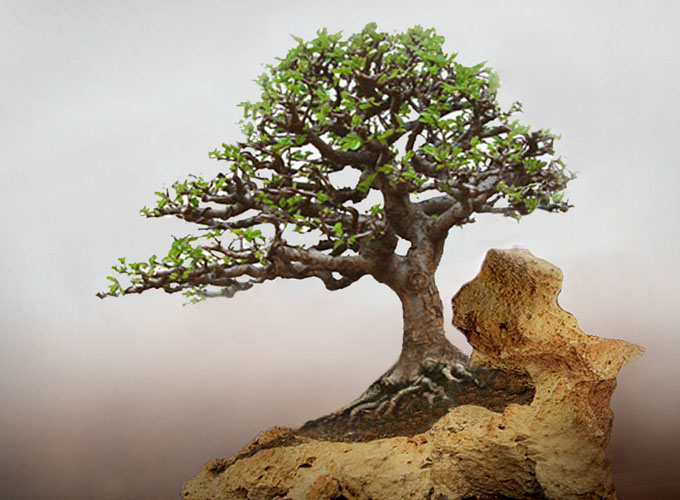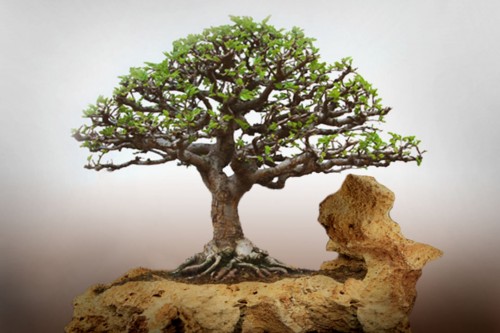 Robert Steven’s simulation of a Chinese elm root-on-rock bonsai submitted by Ikhsan. The original (before) photo is below.
Robert Steven’s simulation of a Chinese elm root-on-rock bonsai submitted by Ikhsan. The original (before) photo is below. Still impressed
No matter how much I try, I don’t see nearly as much as Robert Steven sees when he does his critiques (it’s not even close). So, once again, I am left to sing the praises of Robert’s bonsai wisdom. If you’d like proof of that wisdom, just read on. Or, you can check out Robert’s books and search his name on this blog and read through dozens of his earlier posts. It’s time well spent.
Robert’s critique
How can two nice components create a less-than-beautiful design?
We can all agree that this bonsai and the natural container are very nice (see photo below), but we still feel there is something wrong in the overall composition, which make the design less beautiful than it could be. How can two nice components (container and tree) create a less-than-beautiful design?
It’s about our cognitive sense and our sub-conscious. Our background, experiences, culture, education, social value; what we see and what we learn, all are stored somewhere in our brain. Then, when we see something that doesn’t accord with the data in our brain’s folder, our cognitive sense rejects it and our sub-conscious reacts to the discrepancies and perceives it as less than beautiful.
 Here’s the original photo that Ikhsan submitted.
Here’s the original photo that Ikhsan submitted. So, what’s wrong with this bonsai?
The problems have to do with natural phenomena, the plant’s physiology and morphology, which have not been logically applied in the creation of this bonsai.
- The tree grows in relatively symmetrical manner with slight movement to the right and with the roots spread equally around the base of the trunk.
- The natural container depicts a generally rocky area with the tree growing beside a big rock on its right.
- Logically, in such growing conditions, the tree’s roots system will not spread equally around, but tend to grow to the left for the water source, and grow away from the barrier on the right. Physiologically, the tree will never grow symmetrically or with movement to the right when the roots in the ground are growing to the left
- These are the reasons we feel the design is not as beautiful as it could be, even though the two main elements are nice.
Correcting the flaws
So, to correct it, simply follow the plant physiology and plant morphology. In most case, this just means that you can use common sense when it comes to natural phenomenon. This is the element we sometime overlook in our bonsai design process.
- I would correct the shape of the container by cutting it to make it shorter and to create a downward slope. The objective is to create more natural look that fits the shape of the tree.
- Reposition the tree to lean to the left, cut some of the roots on the right, so that they are slightly one-sided to the left.
- Shorten the right branches and lengthen the left branches to create movement to the left that follows the direction of the roots.
Now, when you look at the simulated image, you see a better composition with more a logical design: a tree growing on a sloping rocky area. When it’s more logical, you feel it’s more beautiful…
General comments
There is more than one way to design any bonsai and my critiques and recommended solutions might not always fit your taste and personal preferences, but I always try to give my opinion based on artistic and horticultural principles.
To understand my concepts better, please read my books Vision of My Soul and Mission of Transformation which are available at Stone Lantern.
Source: Bonsai Bark
0 comments:
Post a Comment